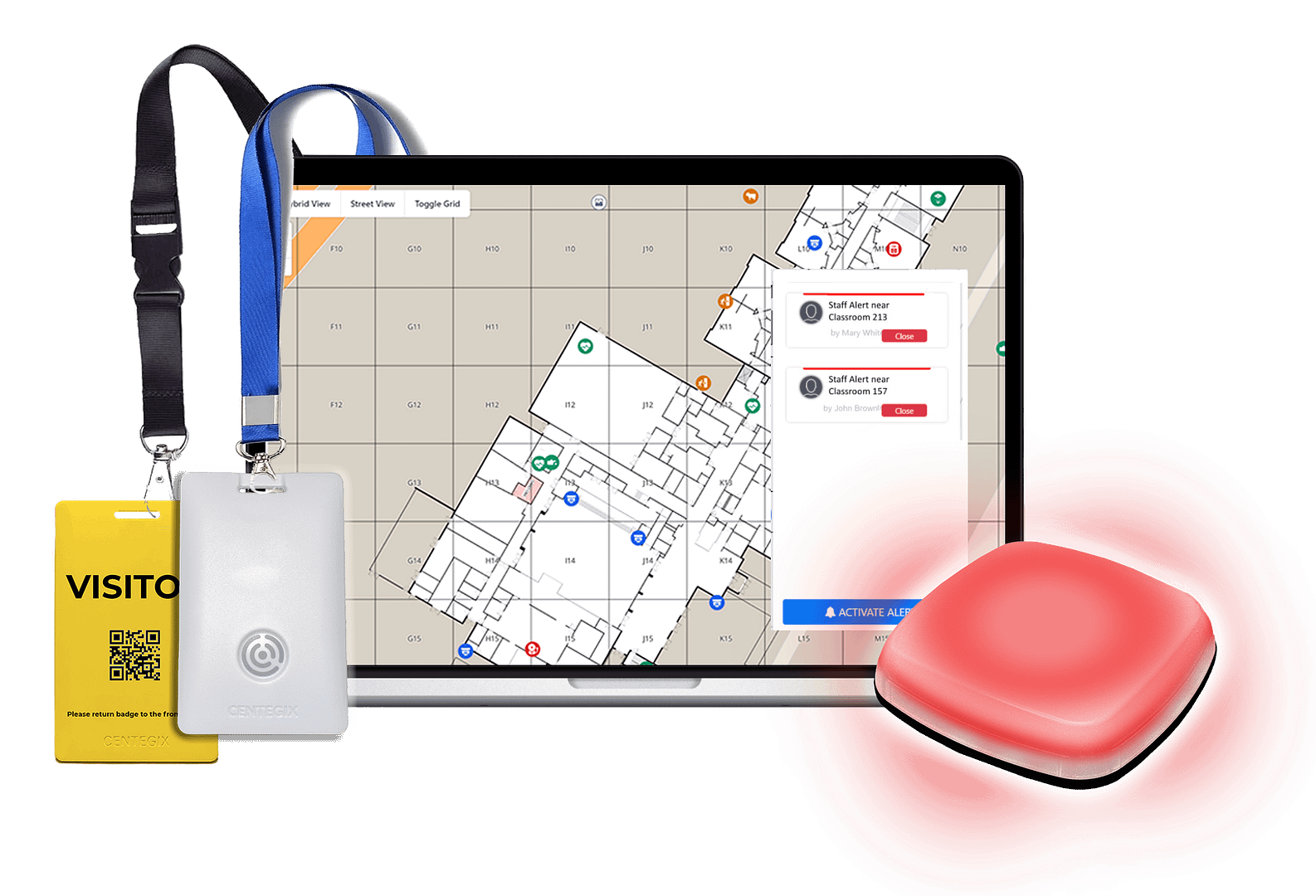Alyssa’s Law is gaining momentum across the U.S. This legislation aims to accelerate law enforcement response time when a life-threatening emergency occurs on a school campus. The law requires that schools integrate silent panic alarms into their school safety plans, which must be directly linked to law enforcement. Alyssa’s law is among a number of state and federal school safety laws that require schools to implement technology that improves response times in emergencies because “time equals life.”
What is Alyssa’s Law?
Alyssa’s Law is legislation championed by Make Our Schools Safe, a school safety advocacy organization founded by Lori and Ilan Alhadeff, who lost their daughter, Alyssa, in the shooting at Marjory Stoneman Douglas High School in Parkland, Florida, in February 2018. Make Our Schools Safe aims to “empower students and staff to help create and maintain a culture of safety and vigilance in a secure school environment.”
The Alhadeff’s advocacy to drive best practices in school safety and advocate for state and federal school safety laws has gained significant momentum in recent years. Alyssa’s Law has passed in:
- New Jersey (February 2019)
- Florida (June 2020)
- New York (June 2022)
- Texas (May 2023)
- Tennessee (May 2023)
- Utah (March 2024)
- Oklahoma (May 2024)
Lawmakers in Arizona, Georgia, Massachusetts, Michigan, Nebraska, Oregon, Pennsylvania, and Virginia have introduced Alyssa’s Law for consideration. Federal lawmakers have also introduced Alyssa’s Law.
Alyssa’s Law and the School Safety Landscape
The tragedies in Parkland, Florida, and Uvalde, Texas, were exacerbated by a critical breakdown in communication between school personnel and first responders. These breakdowns caused confusion and delays, as responders lacked information about what was happening in real time. Accelerating and improving communication is at the heart of Alyssa’s Law, and should be prioritized when developing school safety plans.
After a life-threatening emergency occurs, schools, districts, and state officials conduct post-incident investigations. Many post-incident reports recommend improving emergency communication during crises. Repeated findings advocate in favor of specific functionalities that panic alarm technology provides:
- Ease of use: Staff members must be able to request help quickly while under duress.
- Direct and immediate connection to first responders: staff must be able to communicate starting the moment an emergency begins.
- Campus-wide notifications: audio-visual notifications must make everyone aware of the situation and facilitate immediate lockdown.
- Reliability: school safety technology should not rely on Wi-Fi or cell service to send an alert.
Alyssa’s Law in Utah
Parent advocates in Utah have successfully pushed for passing Alyssa’s law in their state. Utah H.B. 84 is a comprehensive school safety reform bill sponsored by Representative Ryan Wilcox and signed into law by Lieutenant Governor Deidre Henderson in April 2024. Alyssa’s Law is one component of H.B. 84.
Max Schachter, the parent of Alex Schacter, a student killed in the Marjory Stoneman Douglas shooting in Parkland, Florida, thanked Wilcox for sponsoring the legislation and commended Utah for working to improve school safety. Schachter said, “Utah is not waiting until the next tragedy strikes here. They’re proactively going out there implementing lessons learned, taking the terrible tragedy that happened in Parkland and making school safer in Utah.”
H.B. 84 establishes a system for school safety incidents and mandates protocols regarding school resource officers and reporting of bullying and other behavior incidents. Many of the laws’ provisions focus on improving communication and response times during school emergencies. Among its extensive school safety provisions, H.B. 84 requires:
- Wearable panic alert devices for classrooms
- Emergency communication systems in schools and certain state buildings
- Coordinate emergency call information with the state’s intelligence system
- Inclusion of certain school safety data in the annual school disciplinary report
The law specifies that Local Education Agencies (LEAs) “shall provide a staff person in each classroom with a wearable panic alert device that allows immediate contact with emergency services or emergency services agencies, law enforcement agencies, health departments, and fire departments.” Lawmakers and parents recognize that rapid communication during school emergencies can save lives; the provisions in H.B. 84 facilitate the communication necessary for a rapid response.
Alyssa’s Law in Oklahoma
In June 2024, the Oklahoma Legislature passed HB 4073, its version of Alyssa’s Law. Representative Kevin Wallace and Senator Darrell Weaver authored this legislation, requiring all Oklahoma school districts to implement a mobile panic alert system starting in the 2024-25 school year. Representative Wallace said, “Alyssa’s Law ties school security together by coordinating our schools and law enforcement. [Even] the most secure buildings have vulnerabilities when communication isn’t clear.”
Critical features of Alyssa’s Law in Oklahoma include:
- Real-time coordination: The mobile panic alert system must connect emergency service technologies to ensure real-time coordination among multiple first responder agencies.
- Enhanced 911 integration: The system must integrate with public safety answering point infrastructure to transmit 911 calls and mobile activations, providing immediate alerts to designated school personnel.
- Comprehensive emergency response: Emergency responders must receive vital information such as floor plans and caller location to assist during emergencies and ensure a prompt, efficient response.
Oklahoma districts will purchase emergency alert systems from private vendors, and the systems chosen must meet the requirements specified by HB 4073.
The CENTEGIX Safety Platform™: Empowering Schools to Comply with Alyssa’s Law
The CENTEGIX Safety Platform is the foundation of a multi-layered school safety system that helps schools meet Alyssa’s Law requirements. Alyssa’s Law aims to reduce response times and enable first responders to arrive as soon as possible during a school emergency to provide help. Wearable, silent panic buttons are critical in achieving these aims in schools across the U.S.
CrisisAlert™
CENTEGIX CrisisAlert is the most widely used wearable emergency response solution in schools to comply with Alyssa’s Law and federal school safety laws.
CrisisAlert features wearable mobile panic buttons that empower staff to request help during everyday emergencies and extreme crises. CrisisAlert features:
- An easily accessible wearable panic alert badge worn by every staff member
- Automatic alerts to first responders, public safety answering points, and administrators
- Precise location information, down to the floor and room level
- Full campus coverage, indoors and outdoors
- Integration with existing safety investments and emergency services technologies
- A private, installed network that doesn’t rely on Wi-Fi or cellular service to initiate an alert
- Campus-wide emergency notifications using strobes, desktop screen take-overs, and intercom announcements
Safety Blueprint™
Safety Blueprint is the critical incident mapping component of the CENTEGIX Safety Platform. This dynamic digital mapping technology provides vital information to first responders specified in Alyssa’s Law.
Safety Blueprint:
- Displays the precise location of emergency incidents in real time
- Provides precise locations of safety assets, including automatic defibrillator devices (AEDs), first aid kits, fire alarms, fire extinguishers, and other emergency equipment
- Shows evacuation routes
- Provides visual data about a school’s entire campus and facilities
- Integrates with cameras to allow observation of critical incidents in real time
- Enables schools to publish floor plan changes anytime, eliminating the time and expense of using an outside vendor
- Helps schools meet and exceed legal requirements for maintaining critical incident maps
Visitor Management
CENTEGIX Visitor Management supports effective school safety plans by ensuring that all visitors on campus are authorized. Schools minimize the risk of someone coming from outside to cause harm to students and staff when they know who is inside the building and their reasons for being there. Visitor Management enhances safety by allowing school staff to identify visitors and run their information through:
- Criminal databases
- Sex offender databases
- Customized lists created by school staff
Reunification
CENTEGIX Reunification software is a cloud-based solution that digitizes reunification to prioritize efficiency and help school safety teams regain control during and after emergencies. Once fully evacuated, staff and students are marked safe through proprietary CENTEGIX software at the reunification site. Visitor Management provides an accurate, real-time digital roster faster than a manual paper-and-pencil process.
Schools across the U.S. are implementing the CENTEGIX Safety Platform to comply with Alyssa’s Law and state and federal school safety laws. Its layered features allow administrators to create a culture of safety that empowers school staff to communicate quickly in emergencies and reduce response times.
Schedule a demo to learn more here about how CENTEGIX Safety Platform can help your school or district achieve compliance with Alyssa’s Law.












